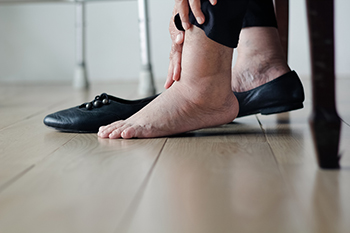Items filtered by date: December 2023
Swollen Ankles From Flying

Swollen ankles from flying, a condition known as edema, often occurs during long flights. This happens due to a combination of factors such as prolonged immobility, changes in cabin pressure, and dehydration, all of which can lead to fluid retention in the lower limbs. When seated for extended periods of time, gravity causes fluid to pool in the feet and ankles, leading to swelling. The reduced cabin pressure in airplanes can also contribute to fluid accumulation in the body tissues. Additionally, the air inside the cabin is quite dry, and if an individual does not drink enough water, it can lead to dehydration, further exacerbating the swelling. To alleviate this issue, it is advisable to move around the cabin and perform simple leg and foot exercises while seated. Additionally, it is beneficial to wear loose clothing and maintain hydration by drinking plenty of water. Compression stockings can also be helpful in preventing swelling by promoting better circulation in the legs. If you are planning on taking a long flight, it is suggested that you make an appointment with a podiatrist for more personalized advice, particularly if you have underlying health conditions.
Swollen feet can be a sign of an underlying condition. If you have any concerns, contact Ross Limon, DPM of Boca Deerfield Footcare Center. Our doctor can provide the care you need to keep you pain-free and on your feet.
Swollen feet are a common ailment among pregnant women and people who stand or sit for extended periods. Aging may increase the possibility of swollen feet and patients who are obese often notice when their feet are swelling too. There may be medical reasons why swollen feet occur:
- Phlebitis - A condition that causes the veins to become inflamed and can also cause leg pain.
- Liver disease - This may lead to low blood levels of albumin which is a protein. This can cause fluid in the blood to pass into the tissues and several areas of the body can become swollen.
- Heart failure - When the heart doesn’t pump properly the blood that is normally pumped back to the heart can pool in the veins of the legs causing swollen feet.
- Kidney disease - One of the main functions of the kidneys is releasing excess fluid in the body. This type of condition can make it difficult for the kidneys to function properly, and as a result the feet may become swollen.
- Deep-vein thrombosis (DVT)- This is a serious condition where blood clots form in the veins of the legs. They can block the return of blood from the legs to the heart which may cause the feet to swell. It is important to be treated by a podiatrist if this condition is present.
Swollen feet can also be caused by bone and tendon conditions, including fractures, arthritis, and tendinitis. Additionally, there may be skin and toenail conditions and an infection may cause the feet to swell. Patients who take medicine to treat high blood pressure may be prone to getting swollen feet.
Many patients elevate their feet to help relieve the swelling and this is generally a temporary remedy. When a podiatrist is consulted the reason behind the swelling can be uncovered and subsequently treated.
If you have any questions please feel free to contact our office located in Deerfield Beach, FL . We offer the newest diagnostic tools and technology to treat your foot and ankle needs.
Are You Suffering From Nerve Damage?
The Danis-Weber Classification of Ankle Fractures

The Danis-Weber classification is a way to categorize ankle fractures based on X-rays. It helps podiatrists understand the type and location of the fracture. There are three types of fractures in this system. Type A is a lower ankle fracture below the joint. It is generally stable and may only need a cast or brace. Sometimes, surgery is necessary if the inner ankle is also damaged. Type B is a fracture that happens at the ankle joint level and moves upward along the outer bone. It can vary in stability. The inner ankle or ligaments may be affected. Type C fractures are fractures above the ankle joint and often involve the inner ligaments, which are unstable and typically require surgery. If you have sustained a broken ankle, it is strongly suggested that you schedule an appointment with a podiatrist for an imaging test and treatment based on which type of fracture is found.
Broken ankles need immediate treatment. If you are seeking treatment, contact Ross Limon, DPM from Boca Deerfield Footcare Center. Our doctor can provide the care you need to keep you pain-free and on your feet.
Broken Ankles
A broken ankle is experienced when a person fractures their tibia or fibula in the lower leg and ankle area. Both of these bones are attached at the bottom of the leg and combine to form what we know to be our ankle.
When a physician is referring to a break of the ankle, he or she is usually referring to a break in the area where the tibia and fibula are joined to create our ankle joint. Ankles are more prone to fractures because the ankle is an area that suffers a lot of pressure and stress. There are some obvious signs when a person experiences a fractured ankle, and the following symptoms may be present.
Symptoms of a Fractured Ankle
- Excessive pain when the area is touched or when any pressure is placed on the ankle
- Swelling around the area
- Bruising of the area
- Area appears to be deformed
If you suspect an ankle fracture, it is recommended to seek treatment as soon as possible. The sooner you have your podiatrist diagnose the fracture, the quicker you’ll be on the way towards recovery.
If you have any questions, please feel free to contact our office located in Deerfield Beach, FL . We offer the newest diagnostic and treatment technologies for all your foot care needs.
Foot Size Changes During Pregnancy

During pregnancy, many women experience changes in their bodies, including foot size growth. This phenomenon is primarily attributed to hormonal changes and increased fluid retention. The hormone relaxin, which helps to relax the ligaments in the pelvis for childbirth, can also affect the ligaments in the feet, leading to an increase in foot size. When it comes to addressing foot size changes during pregnancy, consulting a podiatrist can be beneficial. A podiatrist specializes in diagnosing and treating foot and ankle issues, in addition to providing guidance on managing foot discomfort and swelling during pregnancy. If you have foot-related concerns during pregnancy, it is suggested that you schedule an appointment with a podiatrist to ensure these issues are addressed promptly, increasing your health and well-being during this transformative period.
Pregnant women with swollen feet can be treated with a variety of different methods that are readily available. For more information about other cures for swollen feet during pregnancy, consult with Ross Limon, DPM from Boca Deerfield Footcare Center. Our doctor will attend to all of your foot and ankle needs.
What Foot Problems Can Arise During Pregnancy?
One problem that can occur is overpronation, which occurs when the arch of the foot flattens and tends to roll inward. This can cause pain and discomfort in your heels while you’re walking or even just standing up, trying to support your baby.
Another problem is edema, or swelling in the extremities. This often affects the feet during pregnancy but tends to occur in the later stages.
How Can I Keep My Feet Healthy During Pregnancy?
- Wearing orthotics can provide extra support for the feet and help distribute weight evenly
- Minimize the amount of time spent walking barefoot
- Wear shoes with good arch support
- Wear shoes that allow for good circulation to the feet
- Elevate feet if you experience swelling
- Massage your feet
- Get regular, light exercise, such as walking, to promote blood circulation to the feet
If you have any questions please feel free to contact our office located in Deerfield Beach, FL . We offer the newest diagnostic and treatment technologies for all your foot and ankle needs.
Effects of High Impact Sports on the Feet

Engaging in high-impact sports can be exhilarating, but it is also essential to recognize their potential consequences on the feet. The repetitive stress and force associated with activities such as running, basketball, or soccer can lead to various foot-related issues. The constant pounding on hard surfaces can contribute to stress fractures, impacting the bones in the feet. Additionally, the intense footwork involved in high-impact sports may lead to conditions like plantar fasciitis, where the connective tissue along the bottom of the foot becomes inflamed. Ankle sprains are another common occurrence, as sudden stops or changes in direction can sprain the ligaments. The pressure exerted during high impact activities can also contribute to the development of bunions, calluses, and neuromas. Wearing proper footwear, regular stretching, and attentive foot care are vital for athletes participating in high-impact sports, allowing them to enjoy the thrill of these activities while minimizing the risk of enduring long-lasting foot repercussions. If you are interested in learning more about how high-impact activities can affect the feet, it is suggested that you consult a podiatrist who can offer you additional information on foot protection.
Sports related foot and ankle injuries require proper treatment before players can go back to their regular routines. For more information, contact Ross Limon, DPM of Boca Deerfield Footcare Center. Our doctor can provide the care you need to keep you pain-free and on your feet.
Sports Related Foot and Ankle Injuries
Foot and ankle injuries are a common occurrence when it comes to athletes of any sport. While many athletes dismiss the initial aches and pains, the truth is that ignoring potential foot and ankle injuries can lead to serious problems. As athletes continue to place pressure and strain the area further, a mild injury can turn into something as serious as a rupture and may lead to a permanent disability. There are many factors that contribute to sports related foot and ankle injuries, which include failure to warm up properly, not providing support or wearing bad footwear. Common injuries and conditions athletes face, including:
- Plantar Fasciitis
- Plantar Fasciosis
- Achilles Tendinitis
- Achilles Tendon Rupture
- Ankle Sprains
Sports related injuries are commonly treated using the RICE method. This includes rest, applying ice to the injured area, compression and elevating the ankle. More serious sprains and injuries may require surgery, which could include arthroscopic and reconstructive surgery. Rehabilitation and therapy may also be required in order to get any recovering athlete to become fully functional again. Any unusual aches and pains an athlete sustains must be evaluated by a licensed, reputable medical professional.
If you have any questions please feel free to contact our office located in Deerfield Beach, FL . We offer the newest diagnostic and treatment technologies for all your foot and ankle needs.




